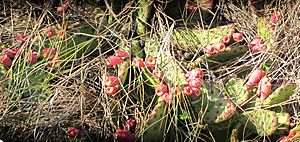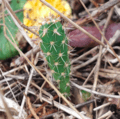Eastern prickly pear facts for kids
Quick facts for kids Eastern prickly pear |
|
|---|---|
 |
|
| Scientific classification | |
| Genus: |
Opuntia
|
| Species: |
humifusa
|
The Opuntia humifusa, often called the Eastern prickly pear, is a cool type of cactus. You might also hear it called devil's-tongue or Indian fig. This cactus grows naturally in parts of eastern North America.
Contents
What Does It Look Like?
Like other prickly pear cacti, the Eastern prickly pear has flat, green stems. These stems are made up of different segments.
You'll find tiny, barbed bristles all over the stem segments. These are called glochids. Sometimes, longer, sharper spines are also present.
The flowers are usually yellow or gold. They grow along the edges of the older stem segments. These waxy flowers can sometimes have red centers. They are about 4–6 cm (1+5⁄8–2+3⁄8 in) wide. This cactus blooms in the late spring.
The fruits are juicy and can be red or purple. They are about 3–5 cm (1+1⁄8–2 in) long. When a fruit ripens, it changes color from green to red. It often stays on the cactus until the next spring. Each fruit holds about 6 to 33 small, flat, light-colored seeds.
How Scientists Classify It
Scientists sometimes group this cactus with a similar type called Opuntia compressa. This means it might be called Opuntia compressa var. humifusa. Other scientists see it as its own unique species.
Where It Grows
This cactus grows naturally in many places. You can find it from dry areas of Montana all the way south to New Mexico. It also grows east to the lower Great Lakes region. Along the East Coast, it stretches from the Florida Keys up to coastal Connecticut.
In Canada, the Eastern prickly pear is rare. It only grows in the Carolinian forest in southern Ontario. Specifically, it's found in Point Pelee National Park.
This cactus is one of Canada's native cactus species. It is considered an endangered species there. Only two small groups of these cacti are known to still exist. Their numbers in southern Ontario have dropped over time. This is because taller plants and trees have grown up around them, blocking out the sunlight the cacti need.
Where It Likes to Live
The Eastern prickly pear really loves sunshine. It doesn't do well in shady spots. It thrives in sunny, hot, and dry places. It also needs soil that drains water well, like sandy soil.
You'll often find Opuntia humifusa growing in open areas. These can be sandy spots, rocky areas, or coastal scrub habitats. Unlike many cacti, this plant can survive cool winters. However, very harsh winter storms can sometimes damage its home.
What It Can Be Used For
The fruits of the Eastern prickly pear are safe to eat. Just be careful of the small, spiny bristles on them! You can scoop out the pulp and strain the seeds. This pulp can be used to make syrup or jelly. The seeds can be lightly roasted and then ground into a meal.
Young cactus segments can also be eaten. You can roast them to remove the spines. Then, peel and slice them to eat like green beans. Another way is to deep fry them. In an emergency, you can peel and chew the leafy segments to get some water.
Gallery
See also
 In Spanish: Opuntia humifusa para niños
In Spanish: Opuntia humifusa para niños








